University E-commerce and Marketing Report: Social Media Impact
VerifiedAdded on 2020/05/16
|10
|2504
|47
Report
AI Summary
This report delves into the multifaceted realm of e-commerce and marketing, with a specific focus on the pervasive influence of social media. It commences with an exploration of online privacy concerns within social networking environments, dissecting the delicate balance between data sharing and user protection. The report further examines the responsibilities individuals bear when engaging with social media platforms, encompassing the blurring lines between personal and professional lives and the implications of online interactions. Finally, it investigates the ethical considerations surrounding location services and their impact on personal privacy, including the tracking of user activities. The report provides a comprehensive overview of how e-commerce, marketing, and social media intersect, offering insights into the challenges and opportunities presented by these evolving digital landscapes. The report draws upon various research papers to support its claims.
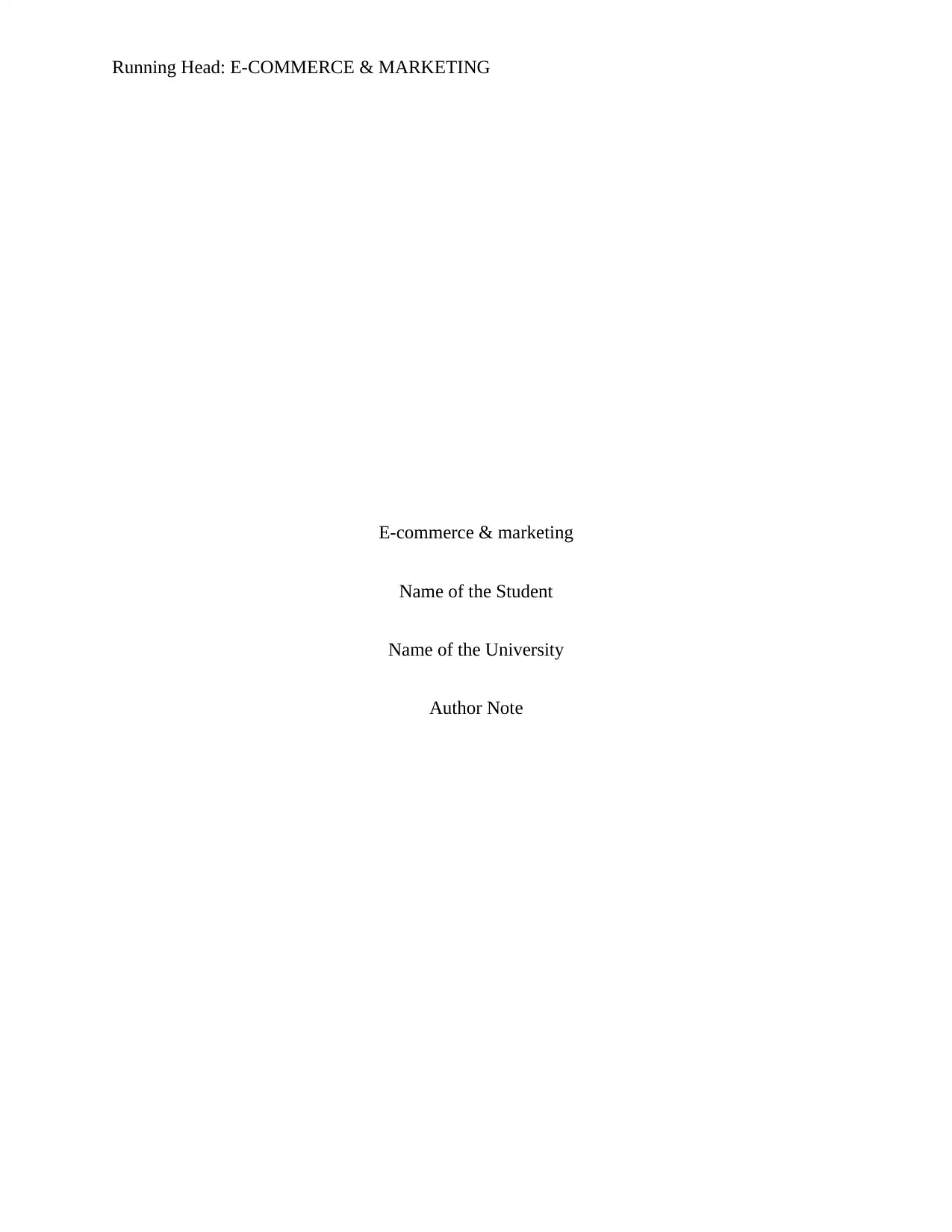
Running Head: E-COMMERCE & MARKETING
E-commerce & marketing
Name of the Student
Name of the University
Author Note
E-commerce & marketing
Name of the Student
Name of the University
Author Note
Paraphrase This Document
Need a fresh take? Get an instant paraphrase of this document with our AI Paraphraser

1E-COMMERCE & MARKETING
EXECUTIVE SUMMARY
Social media or social networking sites provide a huge platform for promoting human
communication. However, like every other advancement it comes with its own limitations; along
with promoting human relationships, it also makes the relationships fragile. Social media poses
the threat of giving away personal data in wrong hands. In this matter, the people should also
remain conscious in order to prevent theft of personal information. Advancement of technology
has brought up the feature of tracking human activities and locations and its ethicality is still
under question. The following report explores several aspects of social media usage.
EXECUTIVE SUMMARY
Social media or social networking sites provide a huge platform for promoting human
communication. However, like every other advancement it comes with its own limitations; along
with promoting human relationships, it also makes the relationships fragile. Social media poses
the threat of giving away personal data in wrong hands. In this matter, the people should also
remain conscious in order to prevent theft of personal information. Advancement of technology
has brought up the feature of tracking human activities and locations and its ethicality is still
under question. The following report explores several aspects of social media usage.
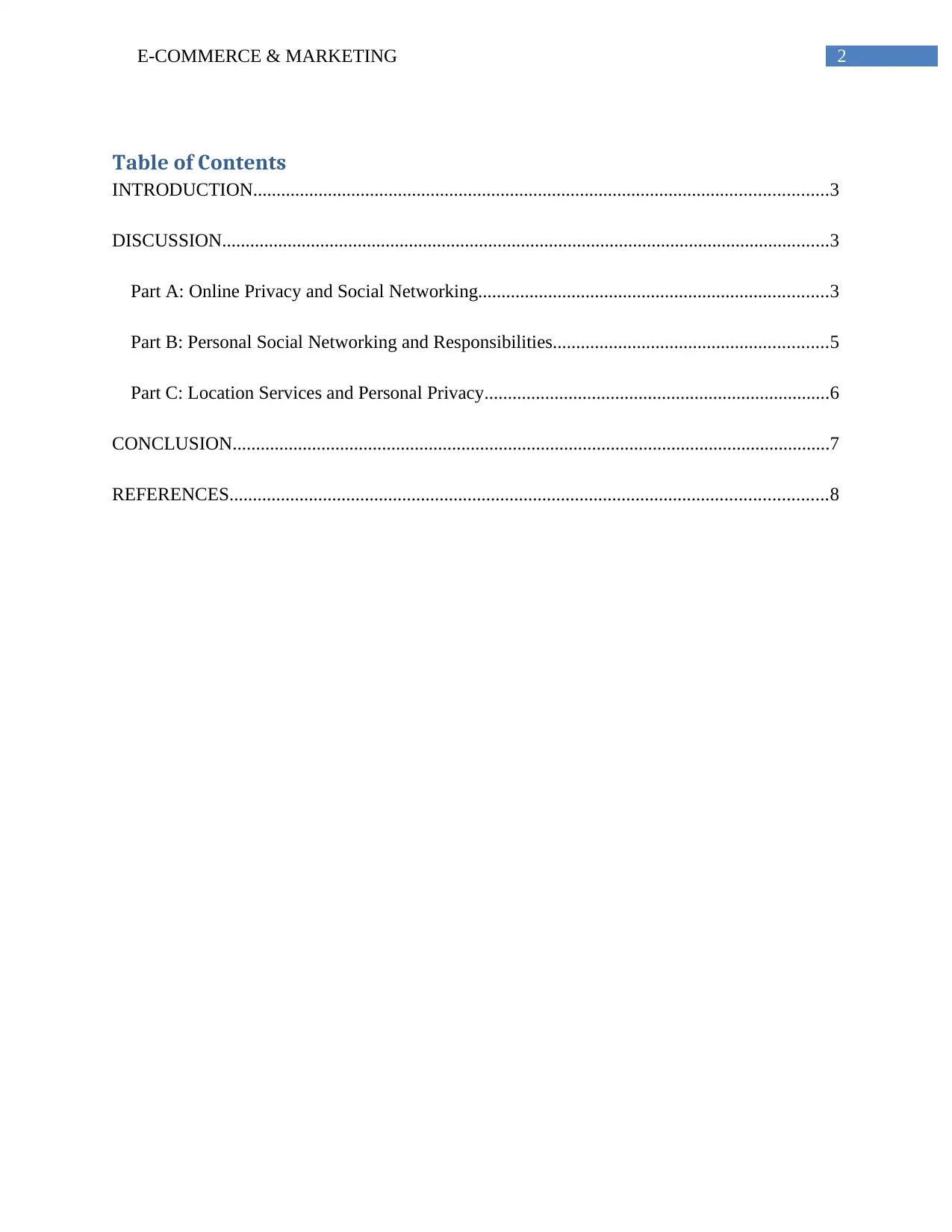
2E-COMMERCE & MARKETING
Table of Contents
INTRODUCTION...........................................................................................................................3
DISCUSSION..................................................................................................................................3
Part A: Online Privacy and Social Networking...........................................................................3
Part B: Personal Social Networking and Responsibilities...........................................................5
Part C: Location Services and Personal Privacy..........................................................................6
CONCLUSION................................................................................................................................7
REFERENCES................................................................................................................................8
Table of Contents
INTRODUCTION...........................................................................................................................3
DISCUSSION..................................................................................................................................3
Part A: Online Privacy and Social Networking...........................................................................3
Part B: Personal Social Networking and Responsibilities...........................................................5
Part C: Location Services and Personal Privacy..........................................................................6
CONCLUSION................................................................................................................................7
REFERENCES................................................................................................................................8
⊘ This is a preview!⊘
Do you want full access?
Subscribe today to unlock all pages.

Trusted by 1+ million students worldwide
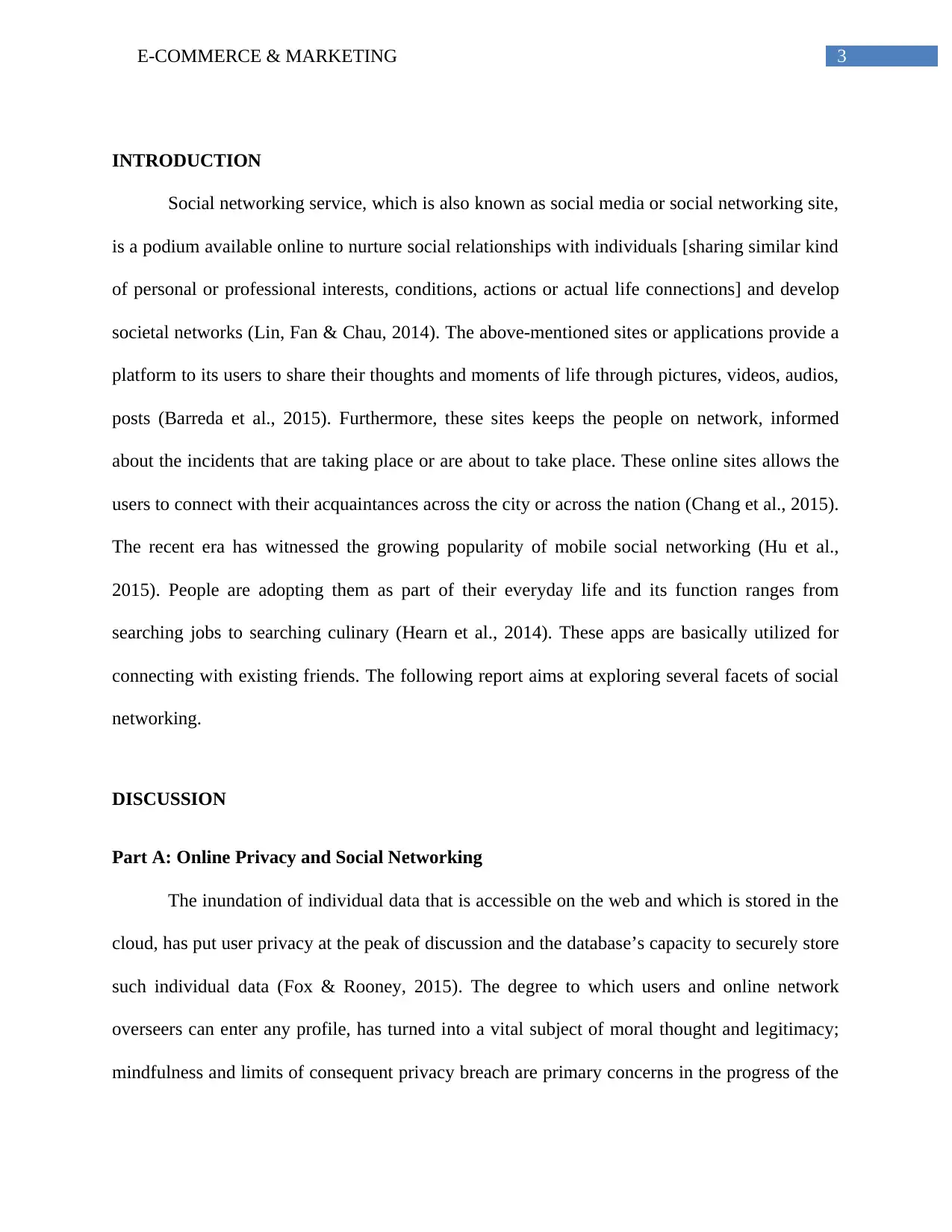
3E-COMMERCE & MARKETING
INTRODUCTION
Social networking service, which is also known as social media or social networking site,
is a podium available online to nurture social relationships with individuals [sharing similar kind
of personal or professional interests, conditions, actions or actual life connections] and develop
societal networks (Lin, Fan & Chau, 2014). The above-mentioned sites or applications provide a
platform to its users to share their thoughts and moments of life through pictures, videos, audios,
posts (Barreda et al., 2015). Furthermore, these sites keeps the people on network, informed
about the incidents that are taking place or are about to take place. These online sites allows the
users to connect with their acquaintances across the city or across the nation (Chang et al., 2015).
The recent era has witnessed the growing popularity of mobile social networking (Hu et al.,
2015). People are adopting them as part of their everyday life and its function ranges from
searching jobs to searching culinary (Hearn et al., 2014). These apps are basically utilized for
connecting with existing friends. The following report aims at exploring several facets of social
networking.
DISCUSSION
Part A: Online Privacy and Social Networking
The inundation of individual data that is accessible on the web and which is stored in the
cloud, has put user privacy at the peak of discussion and the database’s capacity to securely store
such individual data (Fox & Rooney, 2015). The degree to which users and online network
overseers can enter any profile, has turned into a vital subject of moral thought and legitimacy;
mindfulness and limits of consequent privacy breach are primary concerns in the progress of the
INTRODUCTION
Social networking service, which is also known as social media or social networking site,
is a podium available online to nurture social relationships with individuals [sharing similar kind
of personal or professional interests, conditions, actions or actual life connections] and develop
societal networks (Lin, Fan & Chau, 2014). The above-mentioned sites or applications provide a
platform to its users to share their thoughts and moments of life through pictures, videos, audios,
posts (Barreda et al., 2015). Furthermore, these sites keeps the people on network, informed
about the incidents that are taking place or are about to take place. These online sites allows the
users to connect with their acquaintances across the city or across the nation (Chang et al., 2015).
The recent era has witnessed the growing popularity of mobile social networking (Hu et al.,
2015). People are adopting them as part of their everyday life and its function ranges from
searching jobs to searching culinary (Hearn et al., 2014). These apps are basically utilized for
connecting with existing friends. The following report aims at exploring several facets of social
networking.
DISCUSSION
Part A: Online Privacy and Social Networking
The inundation of individual data that is accessible on the web and which is stored in the
cloud, has put user privacy at the peak of discussion and the database’s capacity to securely store
such individual data (Fox & Rooney, 2015). The degree to which users and online network
overseers can enter any profile, has turned into a vital subject of moral thought and legitimacy;
mindfulness and limits of consequent privacy breach are primary concerns in the progress of the
Paraphrase This Document
Need a fresh take? Get an instant paraphrase of this document with our AI Paraphraser
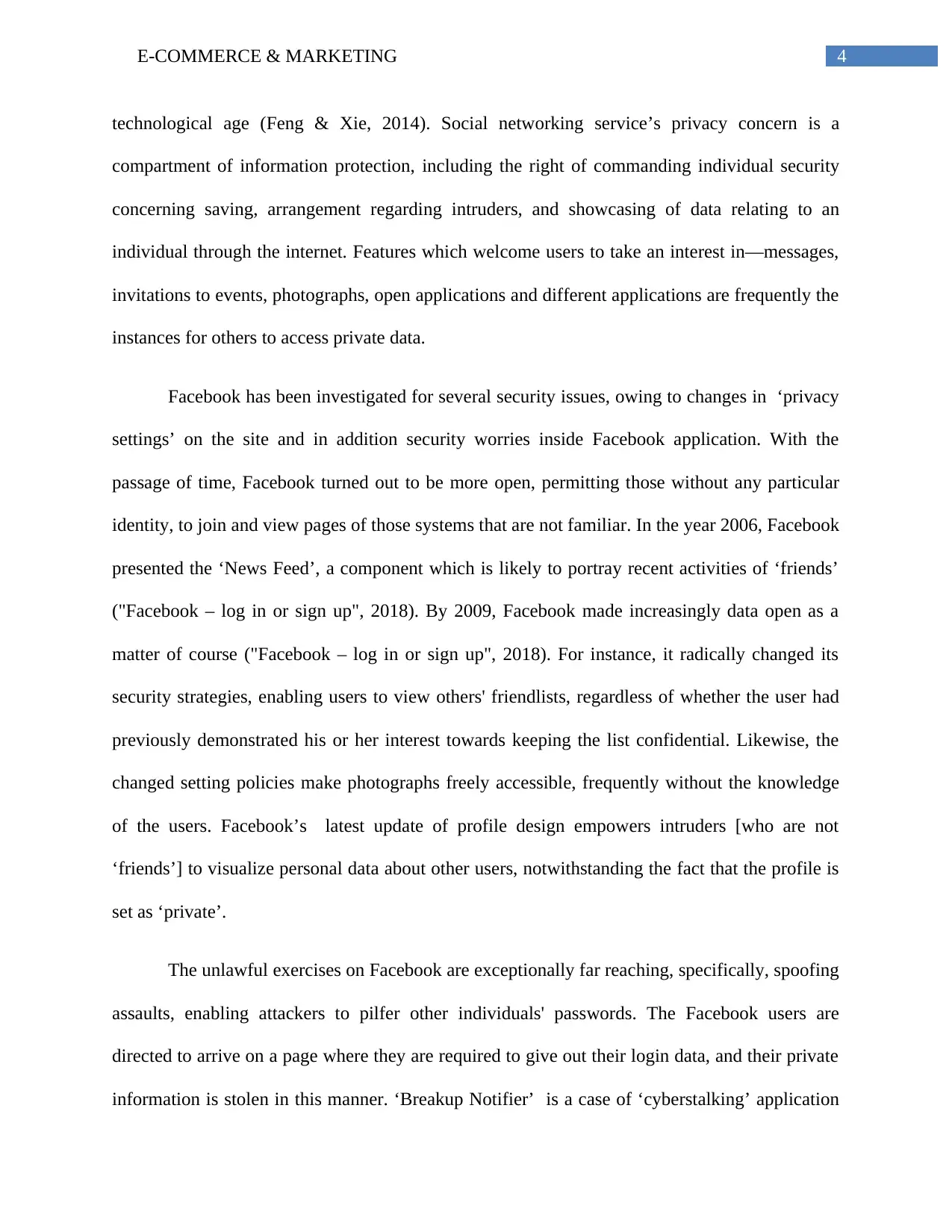
4E-COMMERCE & MARKETING
technological age (Feng & Xie, 2014). Social networking service’s privacy concern is a
compartment of information protection, including the right of commanding individual security
concerning saving, arrangement regarding intruders, and showcasing of data relating to an
individual through the internet. Features which welcome users to take an interest in—messages,
invitations to events, photographs, open applications and different applications are frequently the
instances for others to access private data.
Facebook has been investigated for several security issues, owing to changes in ‘privacy
settings’ on the site and in addition security worries inside Facebook application. With the
passage of time, Facebook turned out to be more open, permitting those without any particular
identity, to join and view pages of those systems that are not familiar. In the year 2006, Facebook
presented the ‘News Feed’, a component which is likely to portray recent activities of ‘friends’
("Facebook – log in or sign up", 2018). By 2009, Facebook made increasingly data open as a
matter of course ("Facebook – log in or sign up", 2018). For instance, it radically changed its
security strategies, enabling users to view others' friendlists, regardless of whether the user had
previously demonstrated his or her interest towards keeping the list confidential. Likewise, the
changed setting policies make photographs freely accessible, frequently without the knowledge
of the users. Facebook’s latest update of profile design empowers intruders [who are not
‘friends’] to visualize personal data about other users, notwithstanding the fact that the profile is
set as ‘private’.
The unlawful exercises on Facebook are exceptionally far reaching, specifically, spoofing
assaults, enabling attackers to pilfer other individuals' passwords. The Facebook users are
directed to arrive on a page where they are required to give out their login data, and their private
information is stolen in this manner. ‘Breakup Notifier’ is a case of ‘cyberstalking’ application
technological age (Feng & Xie, 2014). Social networking service’s privacy concern is a
compartment of information protection, including the right of commanding individual security
concerning saving, arrangement regarding intruders, and showcasing of data relating to an
individual through the internet. Features which welcome users to take an interest in—messages,
invitations to events, photographs, open applications and different applications are frequently the
instances for others to access private data.
Facebook has been investigated for several security issues, owing to changes in ‘privacy
settings’ on the site and in addition security worries inside Facebook application. With the
passage of time, Facebook turned out to be more open, permitting those without any particular
identity, to join and view pages of those systems that are not familiar. In the year 2006, Facebook
presented the ‘News Feed’, a component which is likely to portray recent activities of ‘friends’
("Facebook – log in or sign up", 2018). By 2009, Facebook made increasingly data open as a
matter of course ("Facebook – log in or sign up", 2018). For instance, it radically changed its
security strategies, enabling users to view others' friendlists, regardless of whether the user had
previously demonstrated his or her interest towards keeping the list confidential. Likewise, the
changed setting policies make photographs freely accessible, frequently without the knowledge
of the users. Facebook’s latest update of profile design empowers intruders [who are not
‘friends’] to visualize personal data about other users, notwithstanding the fact that the profile is
set as ‘private’.
The unlawful exercises on Facebook are exceptionally far reaching, specifically, spoofing
assaults, enabling attackers to pilfer other individuals' passwords. The Facebook users are
directed to arrive on a page where they are required to give out their login data, and their private
information is stolen in this manner. ‘Breakup Notifier’ is a case of ‘cyberstalking’ application
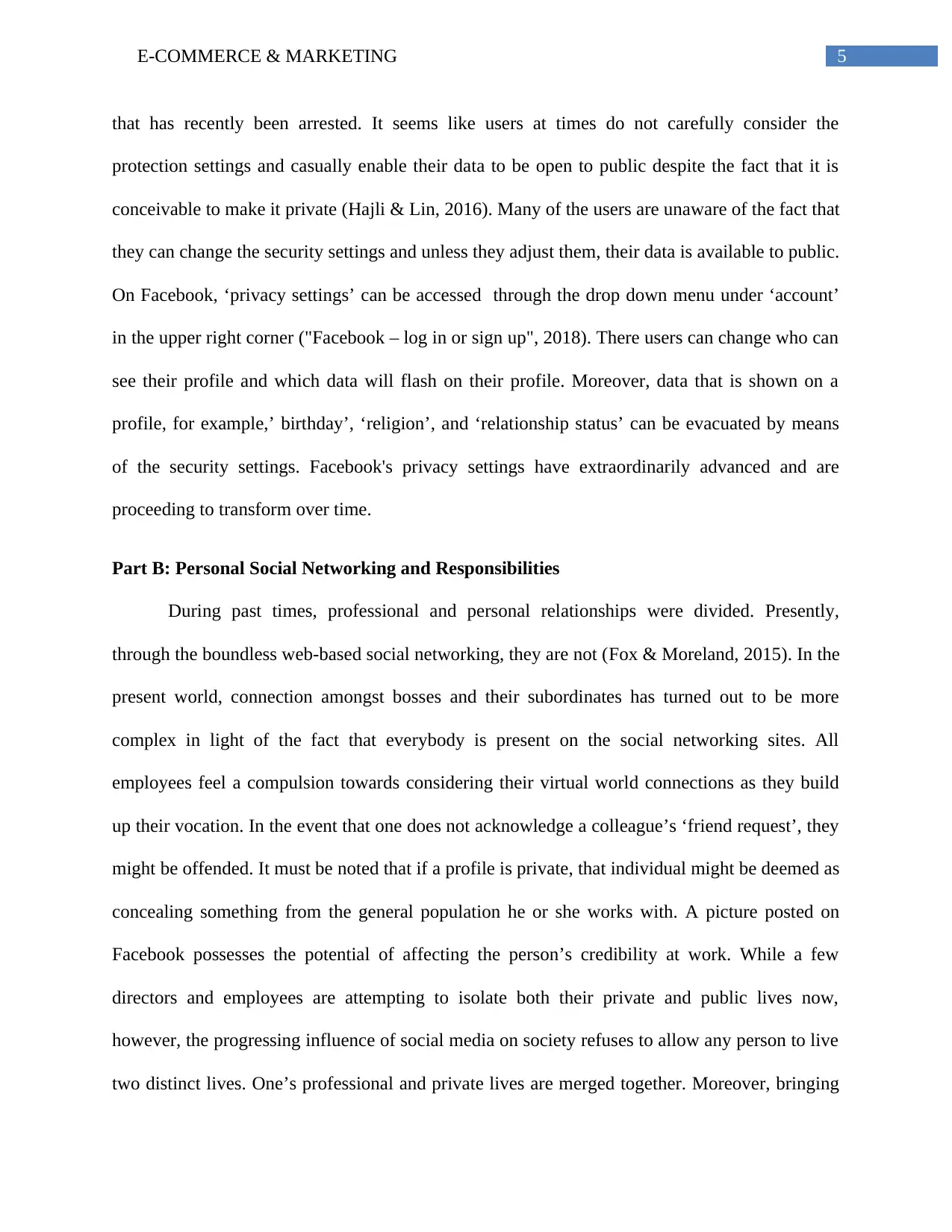
5E-COMMERCE & MARKETING
that has recently been arrested. It seems like users at times do not carefully consider the
protection settings and casually enable their data to be open to public despite the fact that it is
conceivable to make it private (Hajli & Lin, 2016). Many of the users are unaware of the fact that
they can change the security settings and unless they adjust them, their data is available to public.
On Facebook, ‘privacy settings’ can be accessed through the drop down menu under ‘account’
in the upper right corner ("Facebook – log in or sign up", 2018). There users can change who can
see their profile and which data will flash on their profile. Moreover, data that is shown on a
profile, for example,’ birthday’, ‘religion’, and ‘relationship status’ can be evacuated by means
of the security settings. Facebook's privacy settings have extraordinarily advanced and are
proceeding to transform over time.
Part B: Personal Social Networking and Responsibilities
During past times, professional and personal relationships were divided. Presently,
through the boundless web-based social networking, they are not (Fox & Moreland, 2015). In the
present world, connection amongst bosses and their subordinates has turned out to be more
complex in light of the fact that everybody is present on the social networking sites. All
employees feel a compulsion towards considering their virtual world connections as they build
up their vocation. In the event that one does not acknowledge a colleague’s ‘friend request’, they
might be offended. It must be noted that if a profile is private, that individual might be deemed as
concealing something from the general population he or she works with. A picture posted on
Facebook possesses the potential of affecting the person’s credibility at work. While a few
directors and employees are attempting to isolate both their private and public lives now,
however, the progressing influence of social media on society refuses to allow any person to live
two distinct lives. One’s professional and private lives are merged together. Moreover, bringing
that has recently been arrested. It seems like users at times do not carefully consider the
protection settings and casually enable their data to be open to public despite the fact that it is
conceivable to make it private (Hajli & Lin, 2016). Many of the users are unaware of the fact that
they can change the security settings and unless they adjust them, their data is available to public.
On Facebook, ‘privacy settings’ can be accessed through the drop down menu under ‘account’
in the upper right corner ("Facebook – log in or sign up", 2018). There users can change who can
see their profile and which data will flash on their profile. Moreover, data that is shown on a
profile, for example,’ birthday’, ‘religion’, and ‘relationship status’ can be evacuated by means
of the security settings. Facebook's privacy settings have extraordinarily advanced and are
proceeding to transform over time.
Part B: Personal Social Networking and Responsibilities
During past times, professional and personal relationships were divided. Presently,
through the boundless web-based social networking, they are not (Fox & Moreland, 2015). In the
present world, connection amongst bosses and their subordinates has turned out to be more
complex in light of the fact that everybody is present on the social networking sites. All
employees feel a compulsion towards considering their virtual world connections as they build
up their vocation. In the event that one does not acknowledge a colleague’s ‘friend request’, they
might be offended. It must be noted that if a profile is private, that individual might be deemed as
concealing something from the general population he or she works with. A picture posted on
Facebook possesses the potential of affecting the person’s credibility at work. While a few
directors and employees are attempting to isolate both their private and public lives now,
however, the progressing influence of social media on society refuses to allow any person to live
two distinct lives. One’s professional and private lives are merged together. Moreover, bringing
⊘ This is a preview!⊘
Do you want full access?
Subscribe today to unlock all pages.

Trusted by 1+ million students worldwide
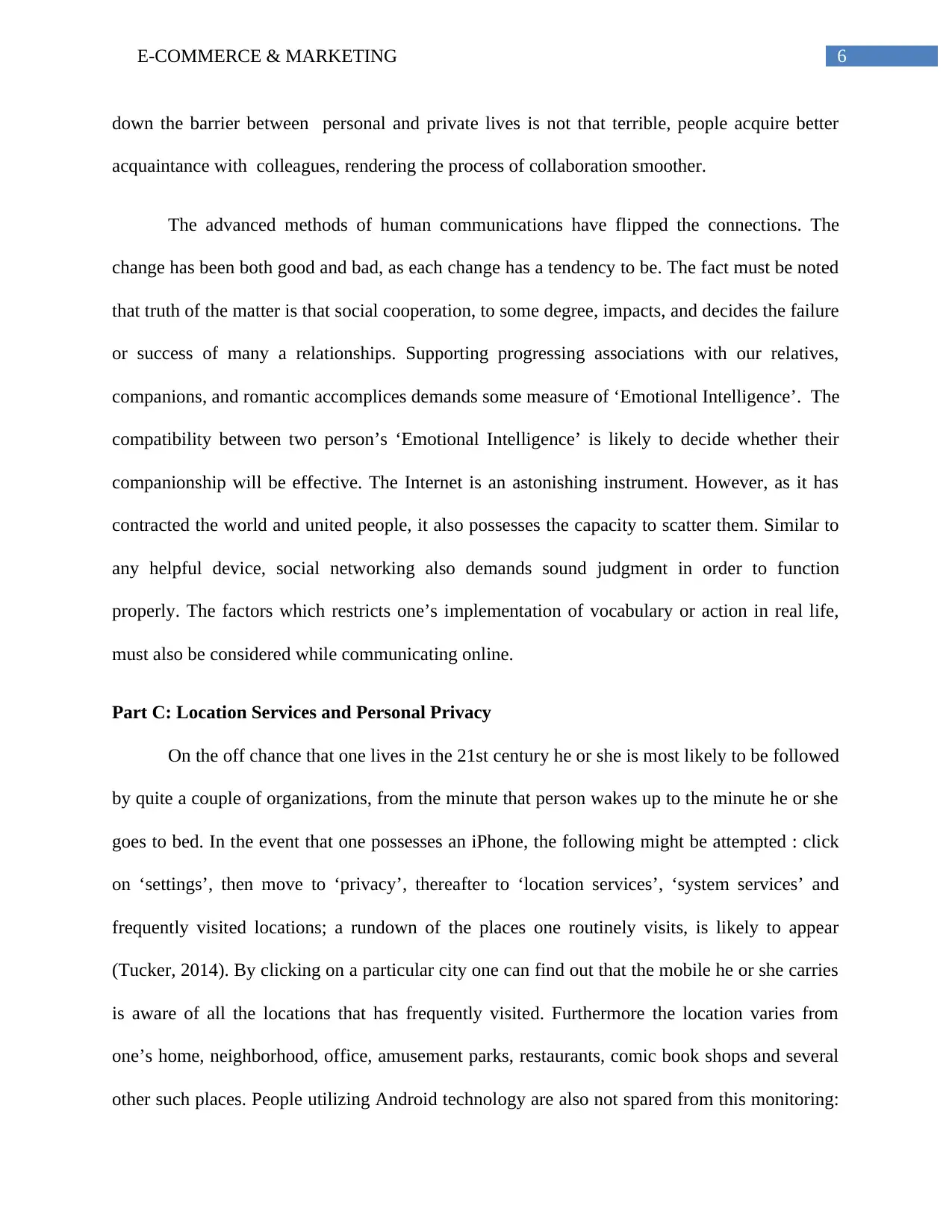
6E-COMMERCE & MARKETING
down the barrier between personal and private lives is not that terrible, people acquire better
acquaintance with colleagues, rendering the process of collaboration smoother.
The advanced methods of human communications have flipped the connections. The
change has been both good and bad, as each change has a tendency to be. The fact must be noted
that truth of the matter is that social cooperation, to some degree, impacts, and decides the failure
or success of many a relationships. Supporting progressing associations with our relatives,
companions, and romantic accomplices demands some measure of ‘Emotional Intelligence’. The
compatibility between two person’s ‘Emotional Intelligence’ is likely to decide whether their
companionship will be effective. The Internet is an astonishing instrument. However, as it has
contracted the world and united people, it also possesses the capacity to scatter them. Similar to
any helpful device, social networking also demands sound judgment in order to function
properly. The factors which restricts one’s implementation of vocabulary or action in real life,
must also be considered while communicating online.
Part C: Location Services and Personal Privacy
On the off chance that one lives in the 21st century he or she is most likely to be followed
by quite a couple of organizations, from the minute that person wakes up to the minute he or she
goes to bed. In the event that one possesses an iPhone, the following might be attempted : click
on ‘settings’, then move to ‘privacy’, thereafter to ‘location services’, ‘system services’ and
frequently visited locations; a rundown of the places one routinely visits, is likely to appear
(Tucker, 2014). By clicking on a particular city one can find out that the mobile he or she carries
is aware of all the locations that has frequently visited. Furthermore the location varies from
one’s home, neighborhood, office, amusement parks, restaurants, comic book shops and several
other such places. People utilizing Android technology are also not spared from this monitoring:
down the barrier between personal and private lives is not that terrible, people acquire better
acquaintance with colleagues, rendering the process of collaboration smoother.
The advanced methods of human communications have flipped the connections. The
change has been both good and bad, as each change has a tendency to be. The fact must be noted
that truth of the matter is that social cooperation, to some degree, impacts, and decides the failure
or success of many a relationships. Supporting progressing associations with our relatives,
companions, and romantic accomplices demands some measure of ‘Emotional Intelligence’. The
compatibility between two person’s ‘Emotional Intelligence’ is likely to decide whether their
companionship will be effective. The Internet is an astonishing instrument. However, as it has
contracted the world and united people, it also possesses the capacity to scatter them. Similar to
any helpful device, social networking also demands sound judgment in order to function
properly. The factors which restricts one’s implementation of vocabulary or action in real life,
must also be considered while communicating online.
Part C: Location Services and Personal Privacy
On the off chance that one lives in the 21st century he or she is most likely to be followed
by quite a couple of organizations, from the minute that person wakes up to the minute he or she
goes to bed. In the event that one possesses an iPhone, the following might be attempted : click
on ‘settings’, then move to ‘privacy’, thereafter to ‘location services’, ‘system services’ and
frequently visited locations; a rundown of the places one routinely visits, is likely to appear
(Tucker, 2014). By clicking on a particular city one can find out that the mobile he or she carries
is aware of all the locations that has frequently visited. Furthermore the location varies from
one’s home, neighborhood, office, amusement parks, restaurants, comic book shops and several
other such places. People utilizing Android technology are also not spared from this monitoring:
Paraphrase This Document
Need a fresh take? Get an instant paraphrase of this document with our AI Paraphraser
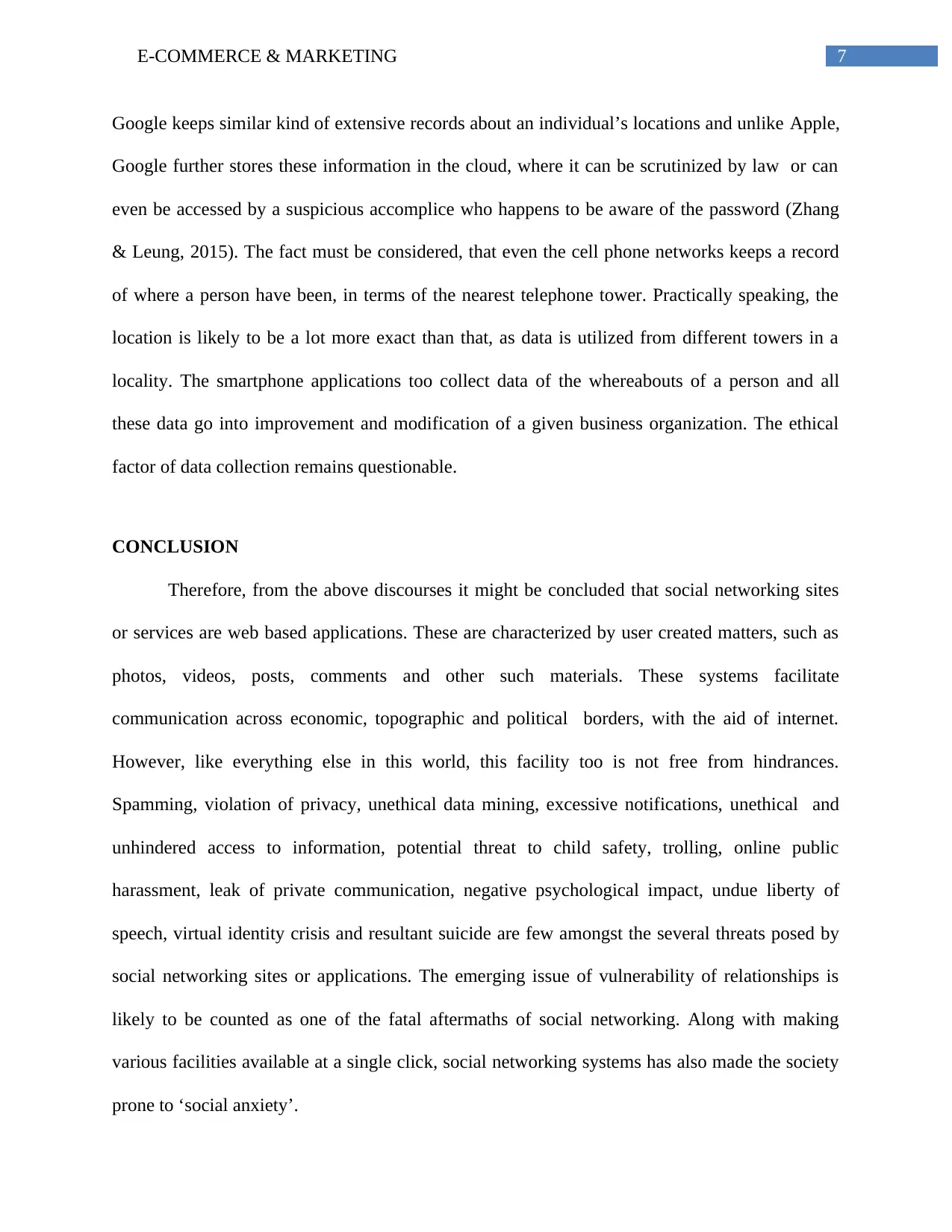
7E-COMMERCE & MARKETING
Google keeps similar kind of extensive records about an individual’s locations and unlike Apple,
Google further stores these information in the cloud, where it can be scrutinized by law or can
even be accessed by a suspicious accomplice who happens to be aware of the password (Zhang
& Leung, 2015). The fact must be considered, that even the cell phone networks keeps a record
of where a person have been, in terms of the nearest telephone tower. Practically speaking, the
location is likely to be a lot more exact than that, as data is utilized from different towers in a
locality. The smartphone applications too collect data of the whereabouts of a person and all
these data go into improvement and modification of a given business organization. The ethical
factor of data collection remains questionable.
CONCLUSION
Therefore, from the above discourses it might be concluded that social networking sites
or services are web based applications. These are characterized by user created matters, such as
photos, videos, posts, comments and other such materials. These systems facilitate
communication across economic, topographic and political borders, with the aid of internet.
However, like everything else in this world, this facility too is not free from hindrances.
Spamming, violation of privacy, unethical data mining, excessive notifications, unethical and
unhindered access to information, potential threat to child safety, trolling, online public
harassment, leak of private communication, negative psychological impact, undue liberty of
speech, virtual identity crisis and resultant suicide are few amongst the several threats posed by
social networking sites or applications. The emerging issue of vulnerability of relationships is
likely to be counted as one of the fatal aftermaths of social networking. Along with making
various facilities available at a single click, social networking systems has also made the society
prone to ‘social anxiety’.
Google keeps similar kind of extensive records about an individual’s locations and unlike Apple,
Google further stores these information in the cloud, where it can be scrutinized by law or can
even be accessed by a suspicious accomplice who happens to be aware of the password (Zhang
& Leung, 2015). The fact must be considered, that even the cell phone networks keeps a record
of where a person have been, in terms of the nearest telephone tower. Practically speaking, the
location is likely to be a lot more exact than that, as data is utilized from different towers in a
locality. The smartphone applications too collect data of the whereabouts of a person and all
these data go into improvement and modification of a given business organization. The ethical
factor of data collection remains questionable.
CONCLUSION
Therefore, from the above discourses it might be concluded that social networking sites
or services are web based applications. These are characterized by user created matters, such as
photos, videos, posts, comments and other such materials. These systems facilitate
communication across economic, topographic and political borders, with the aid of internet.
However, like everything else in this world, this facility too is not free from hindrances.
Spamming, violation of privacy, unethical data mining, excessive notifications, unethical and
unhindered access to information, potential threat to child safety, trolling, online public
harassment, leak of private communication, negative psychological impact, undue liberty of
speech, virtual identity crisis and resultant suicide are few amongst the several threats posed by
social networking sites or applications. The emerging issue of vulnerability of relationships is
likely to be counted as one of the fatal aftermaths of social networking. Along with making
various facilities available at a single click, social networking systems has also made the society
prone to ‘social anxiety’.
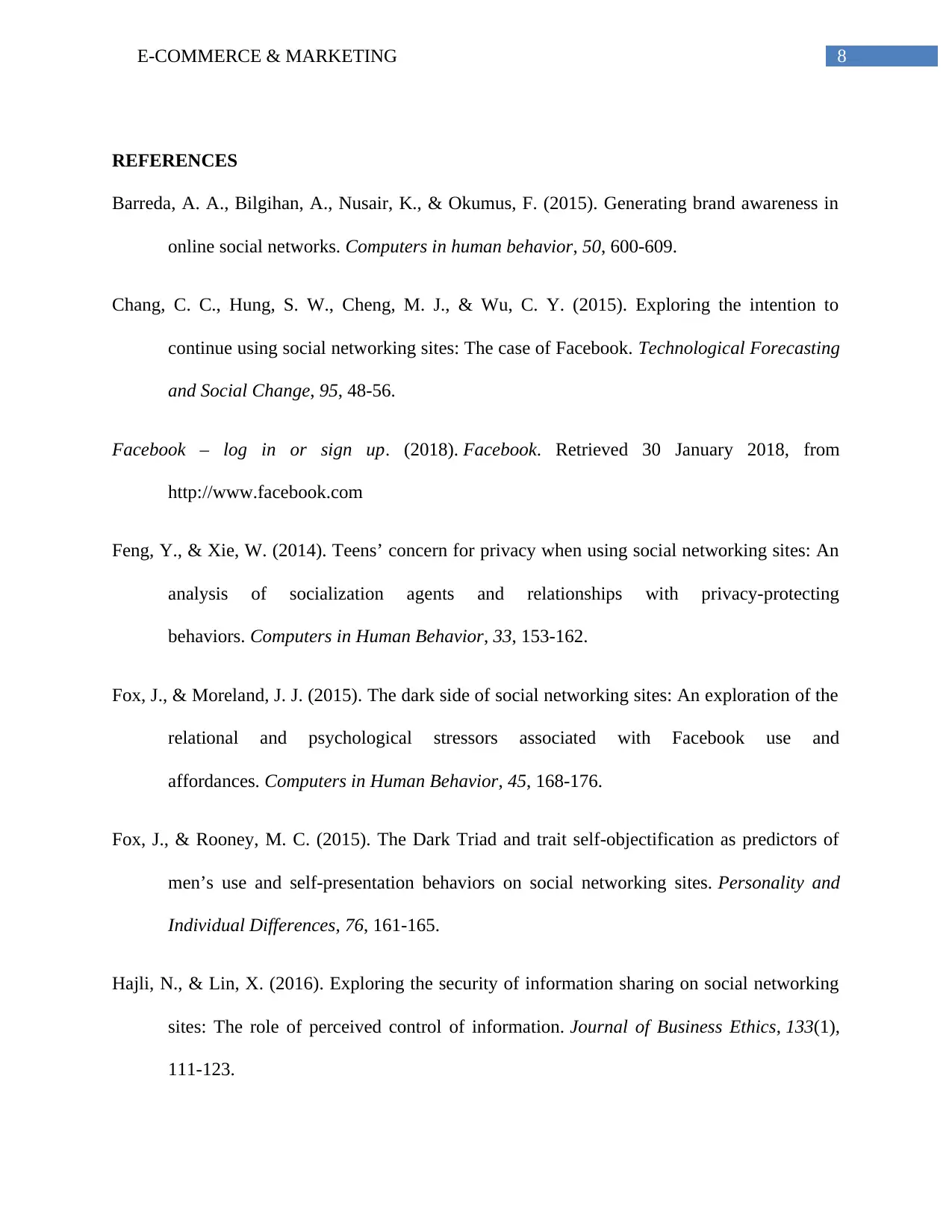
8E-COMMERCE & MARKETING
REFERENCES
Barreda, A. A., Bilgihan, A., Nusair, K., & Okumus, F. (2015). Generating brand awareness in
online social networks. Computers in human behavior, 50, 600-609.
Chang, C. C., Hung, S. W., Cheng, M. J., & Wu, C. Y. (2015). Exploring the intention to
continue using social networking sites: The case of Facebook. Technological Forecasting
and Social Change, 95, 48-56.
Facebook – log in or sign up. (2018). Facebook. Retrieved 30 January 2018, from
http://www.facebook.com
Feng, Y., & Xie, W. (2014). Teens’ concern for privacy when using social networking sites: An
analysis of socialization agents and relationships with privacy-protecting
behaviors. Computers in Human Behavior, 33, 153-162.
Fox, J., & Moreland, J. J. (2015). The dark side of social networking sites: An exploration of the
relational and psychological stressors associated with Facebook use and
affordances. Computers in Human Behavior, 45, 168-176.
Fox, J., & Rooney, M. C. (2015). The Dark Triad and trait self-objectification as predictors of
men’s use and self-presentation behaviors on social networking sites. Personality and
Individual Differences, 76, 161-165.
Hajli, N., & Lin, X. (2016). Exploring the security of information sharing on social networking
sites: The role of perceived control of information. Journal of Business Ethics, 133(1),
111-123.
REFERENCES
Barreda, A. A., Bilgihan, A., Nusair, K., & Okumus, F. (2015). Generating brand awareness in
online social networks. Computers in human behavior, 50, 600-609.
Chang, C. C., Hung, S. W., Cheng, M. J., & Wu, C. Y. (2015). Exploring the intention to
continue using social networking sites: The case of Facebook. Technological Forecasting
and Social Change, 95, 48-56.
Facebook – log in or sign up. (2018). Facebook. Retrieved 30 January 2018, from
http://www.facebook.com
Feng, Y., & Xie, W. (2014). Teens’ concern for privacy when using social networking sites: An
analysis of socialization agents and relationships with privacy-protecting
behaviors. Computers in Human Behavior, 33, 153-162.
Fox, J., & Moreland, J. J. (2015). The dark side of social networking sites: An exploration of the
relational and psychological stressors associated with Facebook use and
affordances. Computers in Human Behavior, 45, 168-176.
Fox, J., & Rooney, M. C. (2015). The Dark Triad and trait self-objectification as predictors of
men’s use and self-presentation behaviors on social networking sites. Personality and
Individual Differences, 76, 161-165.
Hajli, N., & Lin, X. (2016). Exploring the security of information sharing on social networking
sites: The role of perceived control of information. Journal of Business Ethics, 133(1),
111-123.
⊘ This is a preview!⊘
Do you want full access?
Subscribe today to unlock all pages.

Trusted by 1+ million students worldwide
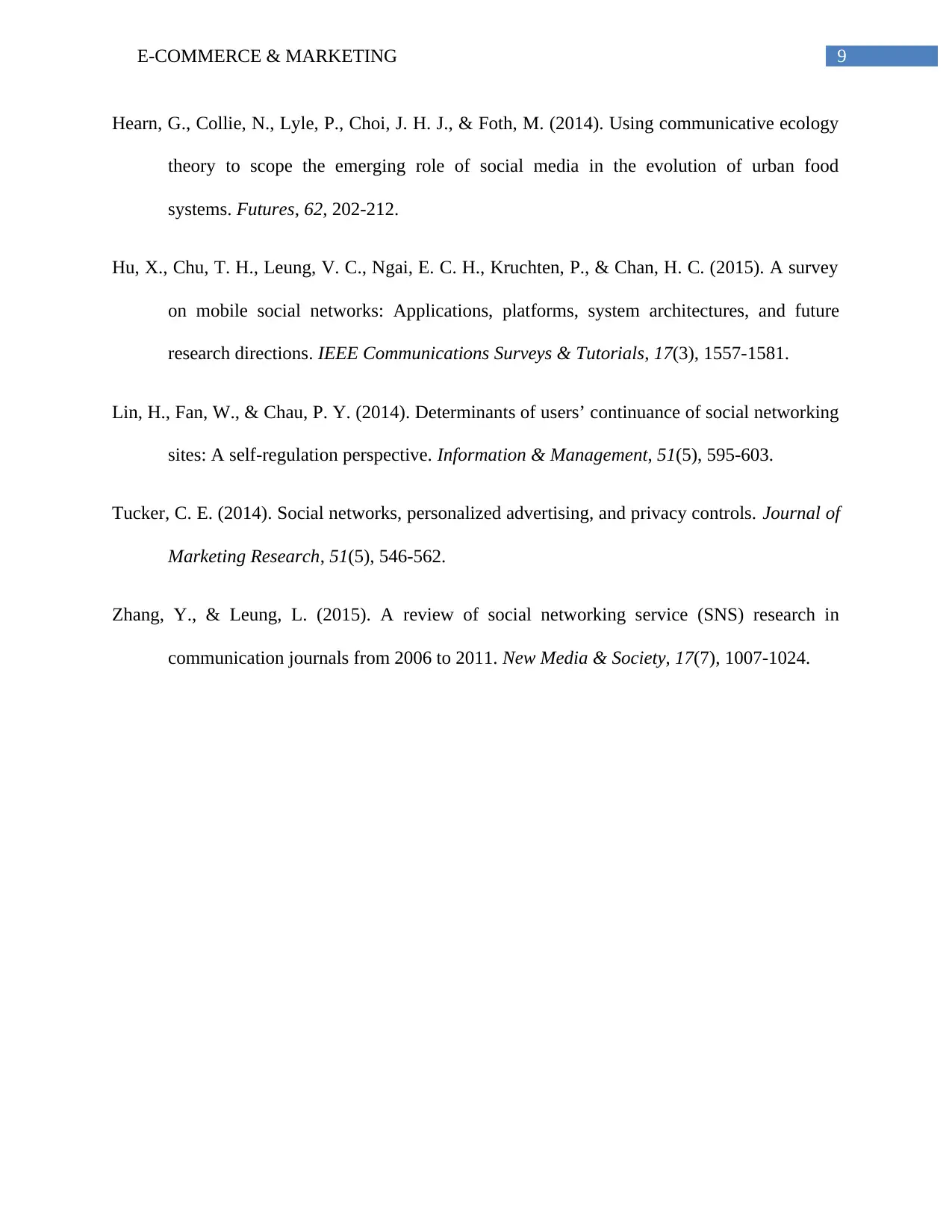
9E-COMMERCE & MARKETING
Hearn, G., Collie, N., Lyle, P., Choi, J. H. J., & Foth, M. (2014). Using communicative ecology
theory to scope the emerging role of social media in the evolution of urban food
systems. Futures, 62, 202-212.
Hu, X., Chu, T. H., Leung, V. C., Ngai, E. C. H., Kruchten, P., & Chan, H. C. (2015). A survey
on mobile social networks: Applications, platforms, system architectures, and future
research directions. IEEE Communications Surveys & Tutorials, 17(3), 1557-1581.
Lin, H., Fan, W., & Chau, P. Y. (2014). Determinants of users’ continuance of social networking
sites: A self-regulation perspective. Information & Management, 51(5), 595-603.
Tucker, C. E. (2014). Social networks, personalized advertising, and privacy controls. Journal of
Marketing Research, 51(5), 546-562.
Zhang, Y., & Leung, L. (2015). A review of social networking service (SNS) research in
communication journals from 2006 to 2011. New Media & Society, 17(7), 1007-1024.
Hearn, G., Collie, N., Lyle, P., Choi, J. H. J., & Foth, M. (2014). Using communicative ecology
theory to scope the emerging role of social media in the evolution of urban food
systems. Futures, 62, 202-212.
Hu, X., Chu, T. H., Leung, V. C., Ngai, E. C. H., Kruchten, P., & Chan, H. C. (2015). A survey
on mobile social networks: Applications, platforms, system architectures, and future
research directions. IEEE Communications Surveys & Tutorials, 17(3), 1557-1581.
Lin, H., Fan, W., & Chau, P. Y. (2014). Determinants of users’ continuance of social networking
sites: A self-regulation perspective. Information & Management, 51(5), 595-603.
Tucker, C. E. (2014). Social networks, personalized advertising, and privacy controls. Journal of
Marketing Research, 51(5), 546-562.
Zhang, Y., & Leung, L. (2015). A review of social networking service (SNS) research in
communication journals from 2006 to 2011. New Media & Society, 17(7), 1007-1024.
1 out of 10
Related Documents
Your All-in-One AI-Powered Toolkit for Academic Success.
+13062052269
info@desklib.com
Available 24*7 on WhatsApp / Email
![[object Object]](/_next/static/media/star-bottom.7253800d.svg)
Unlock your academic potential
Copyright © 2020–2025 A2Z Services. All Rights Reserved. Developed and managed by ZUCOL.





